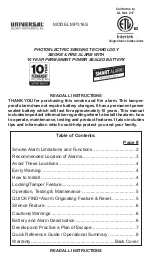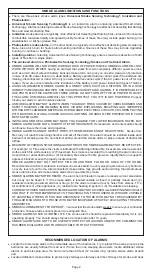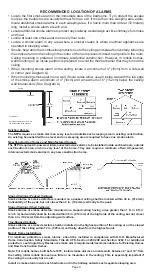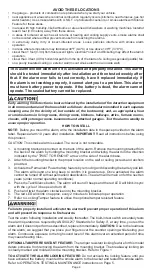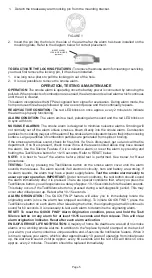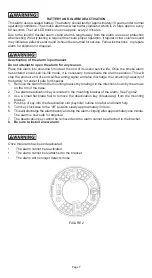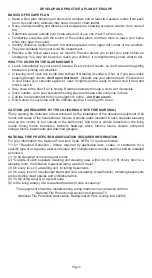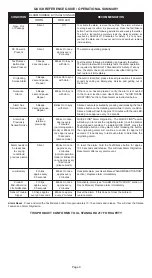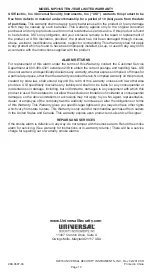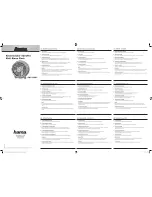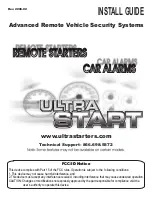
Page 2
SMOKE ALARM LIMITATIONS AND FUNCTIONS
l
There are three basic smoke alarm types:
Universal Smoke Sensing Technology
®
, Ionization and
Photoelectric.
l
Universal Smoke Sensing Technology®
is an ionization alarm containing patented Smart Alarm
Technology. Alarms containing Universal Smoke Sensing Technology are effective at detecting fast flaming
fires and slow smoldering fires.
l
Ionization
smoke alarms are typically more effective at detecting fast flaming fires—fires which consume
combustible materials rapidly and spread quickly. Sources of these fires may include paper burning in a
wastebasket, or kitchen grease fires.
l
Photoelectric smoke alarms,
on the other hand, are typically more effective at detecting slow smoldering
fires—fires which burn for hours before bursting into flame. Sources of these fires may include cigarettes
burning in couches or bedding.
l
Installing alarms
containing Universal Smoke Sensing Technology ensures maximum detection of both
types of fires from a single alarm.
l
The enclosed alarm is a Photoelectric Sensing Technology Smoke and Fire Smart Alarm.
l
SMOKE ALARMS WILL NOT WORK DURING A LOSS OF POWER. SINCE A SMOKE ALARM WILL NOT
WORK WITHOUT POWER, having an alarm(s) that works from two completely different power sources,
such as an AC direct wire with battery backup smoke alarm, can give you an extra measure of protection
in case of an AC power failure or a dead battery. Battery operated alarms cannot work if the batteries are
missing, disconnected or dead. AC (only) powered alarms cannot work if the AC power is cut off for any
reason. If you are concerned about the limitations of the battery or AC power, install both types of alarms.
l
USING AN IONIZATION SMOKE ALARM IN A SMOKY AREA, SUCH AS A KITCHEN, OR IN A HIGH
HUMIDITY AREA NEAR A SHOWER, CAN CAUSE NUISANCE FALSE ALARMS. IT IS PREFERABLE TO
USE PHOTOELECTRIC ALARMS IN THESE AREAS. DO NOT TURN OFF THE AC POWER TO QUIET
THE ALARM. A SMOKE ALARM WILL NOT HELP PROTECT YOU IF IT IS NOT POWERED. Properly
locate your alarm to avoid nuisance alarms.
l
A SMOKE ALARM MAY NOT ALWAYS WARN YOU ABOUT FIRES CAUSED BY CARELESSNESS AND
SAFETY HAZARDS LIKE SMOKING IN BED, VIOLENT EXPLOSIONS, ESCAPING GAS, IMPROPER
STORAGE OF FLAMMABLE MATERIALS, OVERLOADED ELECTRICAL CIRCUITS, CHILDREN PLAYING
WITH MATCHES, NATURAL CAUSES SUCH AS LIGHTNING, OR ARSON. FIRE PREVENTION IS YOUR
BEST SAFEGUARD.
l
INSTALLING SMOKE ALARMS MAY MAKE YOU ELIGIBLE FOR LOWER INSURANCE RATES, BUT
SMOKE ALARMS ARE NOT A SUBSTITUTE FOR INSURANCE. Homeowners and renters alike should
continue to insure their lives and properties.
l
SMOKE ALARMS CANNOT DETECT FIRES IF THE SMOKE DOES NOT REACH THEM.
Smoke from
fires may not reach the sensing chamber and set off the alarm. One alarm should be installed inside each
bedroom or sleeping area. Do not obstruct airflow around the smoke alarm or place in areas of obstructed
airflow.
l
BE AWARE OF VARIOUS SITUATIONS AGAINST WHICH THE SMOKE ALARM MAY NOT BE EFFECTIVE.
For example: (1) Fires where the victim is intimate with a flaming initiated fire; for example, when a person's
clothes catch fire while cooking; (2) Fires where the smoke is prevented from reaching the alarm due to a
closed door or other obstruction or (3) Incendiary fires where the fire grows so rapidly that an occupant's
egress is blocked even with properly located alarms.
SMOKE ALARMS MAY NOT DETECT FIRE ON ANOTHER FLOOR OR AREA OF THE HOME.
Recommended minimum protection is at least one smoke alarm in every sleeping area and every bedroom
on every level of your home. Interconnected smoke alarms may provide earlier warning than stand-alone
smoke alarms since all smoke alarms alarm when one detects smoke.
l
SMOKE ALARMS MAY NOT BE HEARD. The alarm horn in this alarm meets or exceeds current standards,
but it may not be heard if: (1) the smoke alarm is located outside a closed or partially closed door; (2)
residents recently consumed alcohol or drugs; (3) the alarm is drowned out by noise from stereos, TV's,
air conditioners or other appliances; (4) residents are hearing impaired or (5) if residents are sleeping.
CURRENT STUDIES HAVE SHOWN SMOKE ALARMS MAY NOT AWAKEN ALL SLEEPING INDIVIDUALS
AND THAT IT IS THE RESPONSIBILITY OF INDIVIDUALS IN THE HOUSEHOLD WHO ARE CAPABLE
OF ASSISTING OTHERS TO PROVIDE ASSISTANCE TO THOSE WHO MAY NOT BE AWAKENED BY
THE ALARM SOUND OR TO THOSE WHO MAY BE INCAPABLE OF SAFELY EVACUATING THE AREA
UNASSISTED.
l
SMOKE ALARMS ARE NOT FOOLPROOF
.
You must test the smoke alarm weekly to ensure your continued
protection. Smoke alarms cannot prevent or extinguish fires.
l
SMOKE ALARMS HAVE A LIMITED LIFE. The smoke alarm should be replaced immediately if it is not
operating properly. You should always replace a smoke alarm after 10 years.
l
SMOKE ALARMS ARE NOT TO BE USED WITH DETECTOR GUARDS UNLESS THE COMBINATION
HAS BEEN EVALUATED AND FOUND SUITABLE FOR THAT PURPOSE.
RECOMMENDED LOCATION OF ALARMS
l
Locate the first smoke alarm in the immediate area of the bedrooms. Try to protect the escape route as the
bedrooms are usually farthest from an exit. If more than one sleeping area exists, locate additional smoke
alarms in each sleeping area. If a hall is more than 40 feet (12 meters) long, install a smoke alarm at each
end.
l
Locate additional smoke alarms to protect any stairway as stairways act like chimneys for smoke and heat.

